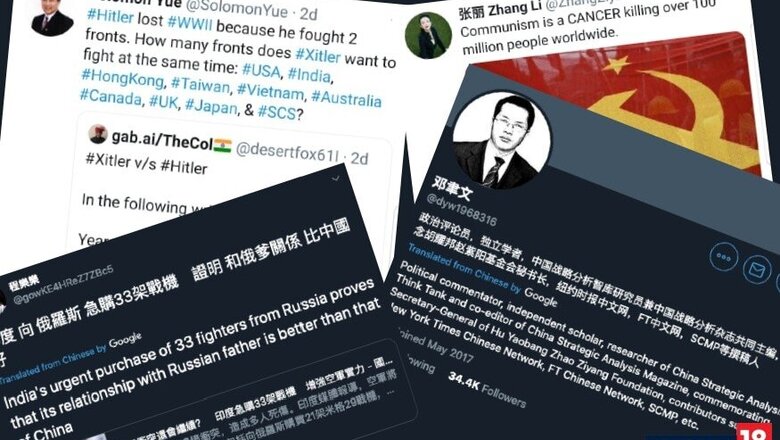
views
Growing voices of dissent among the Chinese diaspora are increasingly dotting the general tone of political discussions on a wide variety of online platforms. While the obvious tone on Chinese state-controlled platforms, as well as open platforms for foreign-dwelling China nationals, is anti-India, there is a considerable amount of murmur against the practices of the Chinese government, too. These voices have been fuelled by China's actions against India at the Galwan valley.
Such anti-government voices have been picked up in a yet-unpublished survey of over 75,000 posts by Seclabs & Systems, a cyber security and sentiment analysis firm. Talking to News18, Shesh Sarangdhar, the chief executive of Seclabs & Systems, was quick to underline that such sentiments have also been spotted among Chinese nationals who work in association with think tanks backed by the government of China. This would be a significant happening, since the Chinese government typically censors and monitors all online activity on a stringent note.
Genuine voices of dissent
Explaining the findings of his report, Sarangdhar says, "Mathematical analysis of social networks reveal degree centrality of above 0.576 on average within the community, eigenvalue of around 0.48 within the community, and betweenness centrality of less than 0.03 within the entire network of open source community that was analysed.”
To simplify these terms, ‘degree centrality’ shows how many people a person is connected to above the average count of a social circle. ‘Eigenvalue centrality’ defines the quality of these connections. Take for example, if one person is connected to 500 people and another person is connected to 400 – however, if these 400 connections have better network amongst them, the Eigenvalue of the latter is higher than the person with more connections. Lastly, ‘betweenness centrality’ defines how interdependent, or connected, two social posts are.
Explaining the major protest voices, Sarangdhar states, “The first group of noted individuals is a bunch of Chinese diaspora journalists, who are not happy with the border standoff. This also suggests the existence of the ‘invisible’ third party, United States of America, in this entire narrative – a party whose impact the Chinese administration must consider.” Apart from them, Sarangdhar further states that there are pro-democracy activists and supporters of Hong Kong and Taiwan, who have raised anti-government voices as well.
The people speaking out
Prominent among these voices are Deng Yuwen and Hu Ping. Deng Yuwen has over 34,000 followers on Twitter, and is a Chinese journalist, writer and commentator on current events. He is also reportedly a member of the Revolutionary Committee of the Chinese Kuomintang. Hu Ping has over 221,000 followers on Twitter.
Deng Yuwen has written about how this border dispute with India reflects poorly on Chinese leadership, and Hu Ping too is quoted to be speaking in view of the current Sino-Indian border conflict. A political commentator, Yuwen believes that if the war between China and India was basically impossible in the past, it will not be ruled out now. But, China will not take the initiative to fire the first shot. He also raises the point that in this conflict between India and China, an invisible third party is America.
印度 向 俄羅斯 急購33架戰機 證明 和俄爹關係 比中國好https://t.co/duwJVHqSNw— 程樂樂 (@gowKE4HReZ7ZBc5) June 23, 2020
Apart from them, there are tweets from China too, which talk about the country’s internal feud. A Chinese citizen, Wang Qianqian, tweeted, “China's internal fighting rumors continue. There are even recordings out there, the internal meeting of the Communist Party of China has been clamoring for "retrospection" and "strike”! (Tweet translated from Mandarin using Google Translate) Over the past 12 hours, this tweet has been taken down from Twitter.
Another Twitter account, which goes by the handle @gowKE4HReZ7ZBc5, tweeted that India's urgent purchase of 33 fighter jets from Russia proves that its relationship with Russia is better than that of China, striking at the heart of Chinese diplomacy. Each of these posts reflect that even the heavily censoring Chinese government could not prevent some voices of dissent from rising, and slipping through their censor filter.
What this means for China
From these examples, what can be inferred from this survey is that such posts are neither organised and nor orchestrated. These murmurs of dissent are more than just murmurs – they are coming from strong and well-regarded sources, and not just random users. They are also disjointed, suggesting that most resistances are independent opinions, not reliant on each other. Lastly, the individuals have followers that are well connected, hence lending further credibility to these voices.
While many may consider that this is only isolated opinion, and hence not a quantifiable narrative, Sarangdhar explains why it is actually not so. He says, “In social network theory, a ‘revolt’ is something that happens sporadically, unless they are manufactured or doctored. It gets connected only when it is either growing, or there is an actor which is prompting these revolts.” Given the nature of Chinese state-sponsored censoring, such an instance is not surprising.
On this note, Sarangdhar further adds, “It has also been seen that pro-democracy voices of China, pro-autonomy voices of Hong Kong and Taiwanese social figures are found using this crisis (the India-China border stand-off) as a rallying point, and urging the world to hold China to task.”
The low betweenness centrality (among these different clusters) is particularly important to note, since it typically demonstrates whether a protest is manufactured (hence at times fake), or authentic. Such an instance was noted during sporadic protests that rose in Arab Spring, which later grew into a ‘revolution’ as the sporadic voices unified. The low centrality here reflects the sporadic angst of Chinese nationals, both inside the nation’s system or settled outside, who are attempting to speak up – not necessarily for India per se, but definitely against the Chinese government.




















Comments
0 comment